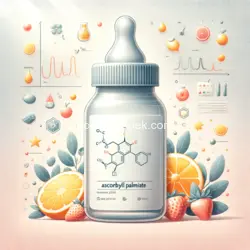
Understanding Ascorbyl Palmitate in Infant Formula: A Quick Guide
In the realm of infant nutrition, every ingredient plays a pivotal role in ensuring the healthy development of a baby. Ascorbyl Palmitate, a name that often appears on the labels of infant formula, is one such component. But what is Ascorbyl Palmitate, and why is it added to infant formula? This blog post aims to demystify this ingredient and explain its significance.
What is Ascorbyl Palmitate?
Ascorbyl Palmitate is a fat-soluble form of Vitamin C. It's a compound made by combining ascorbic acid (Vitamin C) with palmitic acid, a saturated fatty acid. This fusion creates a molecule that possesses both the properties of Vitamin C and the ability to dissolve in fats, making it uniquely beneficial in certain applications, such as in infant formulas.
The Role of Vitamin C in Infant Nutrition
Vitamin C is a crucial nutrient for everyone, including infants. It plays an essential role in the growth and repair of tissues, helps in the absorption of iron, and functions as an antioxidant. For infants, who are in a rapid phase of growth and development, getting adequate Vitamin C is vital for ensuring healthy skin, bones, and connective tissue.
Why Ascorbyl Palmitate in Infant Formula?
Fat-Soluble Property: Since Ascorbyl Palmitate is fat-soluble, it blends seamlessly with the fats present in infant formula. This property ensures a more uniform distribution of Vitamin C throughout the formula.
Stability: Ascorbyl Palmitate is more stable than its water-soluble counterpart, ascorbic acid. This stability is crucial in preserving the nutrient content of the formula during storage.
Antioxidant Benefits: Ascorbyl Palmitate acts as an antioxidant, protecting the fats in the formula from oxidation, which can lead to spoilage and the development of off-flavors.
Enhanced Absorption: Its fat-soluble nature may enhance the absorption of Vitamin C in the infant's body, especially when consumed with other dietary fats.
Safety and Regulation
The addition of Ascorbyl Palmitate in infant formula is strictly regulated. Health authorities, like the U.S. Food and Drug Administration (FDA) and the European Food Safety Authority (EFSA), have guidelines and limits for its use, ensuring that it is safe and beneficial in the formula.
Conclusion
Ascorbyl Palmitate plays a multifaceted role in infant formula. It not only provides the essential benefits of Vitamin C but also improves the formula's stability and quality. Understanding these components helps reassure that infant formulas are formulated with both nutrition and safety in mind, catering to the delicate needs of infants. As always, for specific concerns about infant nutrition, consulting with a healthcare provider is advised.



